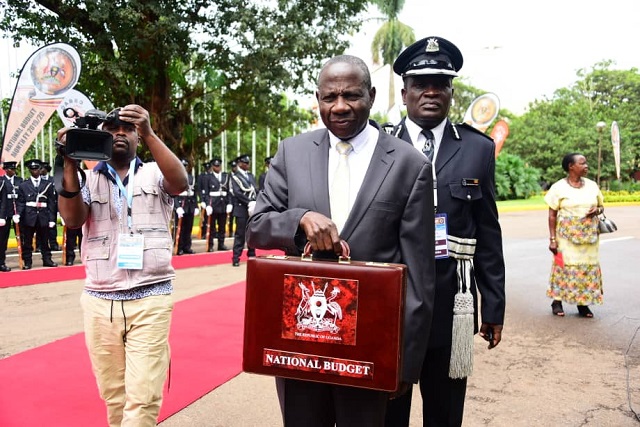
Kampala, Uganda | THE INDEPENDENT | The Government plans to spend 1.826 Trillion Shillings on repayments of external debt next financial year, up from 1.12 trillion Shillings in the current year. The increase is attributed to an increase in non-concessional financing.
Non-concessional loans usually carry commercial interest rates which are higher, while the grace periods given are also shorter than those of concessional or soft loans.
A further 4.960 Trillion Shillings will be spent on interest payments, with3.850. Trillion Shillings projected to cover domestic interest payments.
According to the National Budget Framework Paper 2021/2022, the total resource envelope in the next financial year is projected at 45.658 Trillion Shillings, which is a slight increase of 164 billion shillings from the current budget.
A total of 10.330 Trillion Shillings is expected from external borrowing, with Shs 6.744 trillion coming in form of project loans, while Shs 3.585 trillion is expected as budget support loans.
According to the Bank of Uganda, by the end of June 2020, Uganda’s total debt was 56.526 trillion, or about 48% of the value of the economy (GDP) and this is expected to grow to about 66 trillion.
The Ministry of Finance, Planning and Economic Development has focused the 2021/2022 budget on local resource mobilisation as critical in the fulfilment of the budget theme – Industrialisation for Inclusive Growth, Employment and Wealth Creation in FY 2021/22, which it hopes will help achieve increased investments to boost employment, import substitution and exports.
Other expected outcomes are better social services, physical infrastructure and affordable financing for entrepreneurs.
To achieve these outcomes, the government will have to boost local resource mobilization, rationalize domestic borrowing to reduce the level from 4.8% currently to 1.5% of GDP next financial year.
But it also focuses on the mobilization of additional external borrowing, preferably on concessional or near concessional terms and utilizing this financing for projects that will provide adequate returns to investment; and maintain debt to GDP ratio at sustainable levels.
The government faces a bigger task than before, to finance the next budget, as its resources have declined especially since the outbreak of the Covid 19 pandemic, but which pandemic also affected Uganda’s traditional lenders.
The economy was already performing below capacity, basing on the deficits the Uganda Revenue Authority posted in the period preceding the pandemic.
The government will reduce borrowing from the local financial markets to 2.484 trillion shillings from the more than 3 trillion it is expected to borrow this year.
It says it will continue to reduce domestic borrowing to stabilize the market, in response to complaints from the private sector that it is unfair for the government to compete for loans on the local market with the private sector borrowers.
“As long as the government continues to borrow from the local market, especially through offering Treasury Bills and Bonds, banks will always prefer to lend to the government because it is safer compared to lending to private borrowers.
This leaves the private sector with fewer options, while banks are also tempted to set high-interest rates to discourage private investors,” said PSFU Chief Executive, Gideon Badagawa.
Yet the government needs the money to fund its projects.
The Ministry of Health will need more resources to strengthen its capacity, especially to respond to the pandemic.
More loans and grants from developing partners will come in handy, as has been witnessed over the second and third quarter when the International Monetary Fund increased financing to African countries including Uganda.
Uganda received $491 million (1.9 trillion shillings) from the IMF in May, before getting another $300 million (1.1 trillion shillings) from the World Bank, bringing the total debt burden to 40.8% of GDP.
As of the end of June, Uganda’s public debt was 56.5 trillion shillings, with about two-thirds of the debt held by external creditors, according to the Bank of Uganda, before the World Bank loan.
Government through the Ministry of Finance, Planning and Economic Development has expressed interest in benefiting from the G-20 Debt Service Suspension Initiative, which would help deal with the impact of the COVID-19 pandemic.
Uganda, like many other African countries, will find getting external loans harder than in recent years as bilateral lenders like China, USA and European countries are also adjusting their spending to deal with declining resources caused by the Covid-19 pandemic, and also to strengthen their healthcare systems.
Chinese infrastructure lending to African countries is expected to slow over the next 1-2 years as the risk to default grows.
African countries are also increasingly becoming cautious about loans from China, demanding that when China finances a project, a bigger part of the financing be in form of a grant.
Of the total Ugandan external debt burden, China accounts for a fifth of it or 5.9 trillion with most of it in on-going infrastructure projects.
China is also heavily indebted, accounting for 63% of the total debt that the G20 countries have lent to other countries.
The country is also getting more involved in the Paris Club, a group of top lending countries, and this will help China coordinate its lending structure with the other countries.
It will also see China become more selective in lending especially to Africa, with an analyst saying African countries will be denied expected loans amounting to more than 30 billion dollars over the next five years.
So, Uganda has to expand its search for loans to more sources.
One traditional development partner for Uganda is the UK, which, unfortunately, has also been hit hard by the pandemic, amidst economic restructuring programs as it implements its exit from the European Union.
Due to the economic damage caused by the pandemic, the British government has told Parliament “the level of Overseas Development Assistance (aid) spend is likely to decrease this year,” and according to Care International, this could be up to £3 billion mainly meant for poor countries in Africa and Asia.
The UK also often tags its aid to human-rights situations in the recipient countries.
It will be important for Uganda to mind how Europe, the UK and the USA view the events that preceded Uganda’s general elections, the electoral process and results and how the post-election period is handled by the government.
The EU has already condemned the way the security forces behaved towards civilians, the media, the civil society and political opponents before the elections.
Uganda will also be hoping that the United States’ new administration led by President Joe Biden will not toe the line that was taken by Donald Trump when he announced measures to cut funding for programs in Africa.
African countries are among those affected when the US cut funding programs under the World Health Organization.
Trump’s foreign policy was not well articulated and his relations with African leaders was largely not understood by either analyst of US politicians.
This unpredictability is expected to end with his exit and the way the US views and response to African politics and human rights will be clearer with Biden in office.
********
URN
 The Independent Uganda: You get the Truth we Pay the Price
The Independent Uganda: You get the Truth we Pay the Price




This does work out but far have they reached with the covid loans now?
Need some briefs on getting loaned in this period.